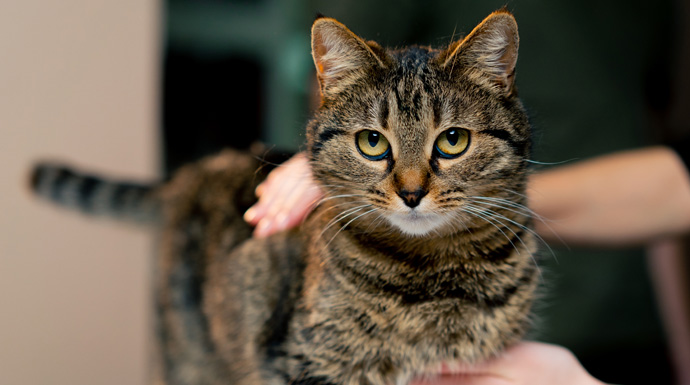September is Happy Cat Month, a time dedicated to promoting feline well-being and educating pet owners on the importance of keeping their cats healthy and happy. Created by the CATalyst Council, this month-long initiative emphasizes the significance of preventive care, proper nutrition, and creating enriching environments for our feline companions.
As veterinary professionals, you play a crucial role in guiding cat owners to provide the best possible care for their pets. And what better way to build community than by incorporating Happy Cat Month into your practice!
Whether through client education, behavioral tips, or pain management strategies, this is an opportunity to strengthen the bond between pet owners and their feline friends while boosting the overall well-being of your patients.
Purr-fect preventive care: Keeping feline health on track

Happy cats are healthy cats, and preventive care is the cornerstone of maintaining
that happiness. While cats are known for their independence, they still need regular
vet checkups to keep their nine lives in top shape. September’s Happy Cat Month
is the ideal time to remind pet owners about the benefits of routine wellness visits.
Here’s how we think you can integrate preventive care discussions into your practice
this month:

Host a happy cat health clinic
Encourage clients to schedule wellness visits during September, offering special check-ups focused on common feline health issues. You could even throw in a quirky incentive like “free ear scratches with every exam.”
Create a “wellness cat” checklist
Distribute a simple checklist to clients that outlines basic preventive care steps, such as vaccinations, parasite prevention, dental care, and weight management.
Promote senior cat care
Older cats are especially good at hiding discomfort. Use Happy Cat Month to stress the importance of more frequent visits for senior feline patients to monitor for age-related issues.
Whisker woes: Managing feline behavior for happier cats

You know even the most composed feline can face behavioral woes. From stress and anxiety to scratching and litter box aversions, these issues can seriously impact a cat's happiness and health. During Happy Cat Month, it’s time to address these “whisker woes” head-on and offer solutions to improve feline mental well-being.
As veterinary professionals, you’re not just healers of physical ailments - you’re also the front line in identifying and managing behavior-related concerns.

Reduce stress in the clinic
For many cats, vet visits are the ultimate stress test. Equip your team with tips on reducing feline anxiety during appointments. Whether it’s creating a quieter environment, using pheromone diffusers, or educating clients about pre-visit calming strategies, lowering stress can make vet visits less traumatic.
Stress free spaces at home
Advise your clients on creating peaceful, enriching environments for their cats at home. Suggest simple changes like providing high perches, cozy hideaways, and plenty of toys to keep them mentally stimulated. Remind them that a “happy cat” doesn’t just need love and food—it needs mental and emotional enrichment.
Behavioral health monitoring
Use this month as an opportunity to help clients understand that sudden changes in behavior - like over-grooming or hiding - might indicate underlying medical or emotional issues. Teach them to recognize early signs of distress and encourage them to schedule a vet visit when these behaviors crop up.
Feline fine: Vet techs as cat happiness heroes

Vet techs are central to the feline happiness equation. Happy Cat Month provides the perfect opportunity to showcase how veterinary technicians can become feline happiness champions, both in and out of the exam room.
Your day-to-day interactions with cats and their owners allow you to make a direct impact on a cat’s health and happiness.
Use your time with clients to discuss the small things that can make a big difference in a cat’s life. From discussing the right kind of toys to suggesting environmental enrichment, you’re in the perfect position to offer practical, easy-to-implement tips for keeping cats engaged and content.
Many cat owners don’t know how to help their pets de-stress. Take a moment during appointments to show clients how to use calming techniques, from using pheromone sprays to offering gentle petting methods that can ease anxiety. A few simple demonstrations can improve a cat’s vet experience and overall happiness at home.
As the first person many clients encounter, you can introduce them to Happy Cat Month. Mention the initiative as part of your interactions, suggesting specific actions owners can take to promote their cat’s well-being, such as scheduling wellness exams or trying new forms of mental stimulation.
Vet techs are the glue that keeps a veterinary practice running smoothly, and this month is the time to step up as a champion for feline happiness.
Wrapping up happy cat month

When Happy Cat Month comes to a close, the lessons learned and the habits formed can carry on throughout the year. Whether through preventive care, behavioral support, pain management, or client education, veterinary professionals play a vital role in keeping cats happy and healthy.
By embracing this initiative, you not only make a difference in the lives of the cats you care for but also strengthen the relationships between pet owners and your practice. Happy Cat Month is more than just a celebration of our feline friends - it’s an opportunity to enshrine a new standard of care and help every cat get the love, attention, and medical support they deserve.
So keep the purrs coming! Whether you’re a vet or vet tech, this month is your chance to be a hero in the eyes of both your patients and their owners. Here’s to healthier, happier cats - this month and beyond!



